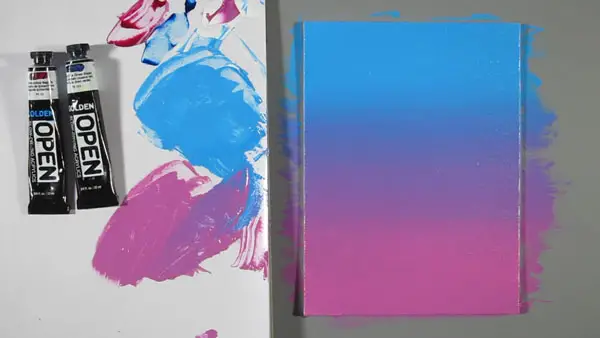OPEN – Slow-Drying – Acrylics

What should you know about the GOLDEN Open Acrylics?
Golden’s open acrylic series dry almost as slow as oil paint.
So the question is, why is it necessary to have Acrylics, that’s primary feature is their fast drying quality, as opposed to oils’?
There are a number of uses you might prefer slow-drying acrylics instead of regular acrylics or oil paint.
Open Acrylics are slow-drying Acrylic paint that have a little bit softer consistency than regular Acrylic paints. The increased working time makes it possible to work with them similarly to oil paints. Due to their ‘open’ quality they are a versatile paint medium, that are particularly recommended for portraiture and landscape painting that rely on soft brushstrokes, shades, glazing and fine details. They are also suitable for some printmaking techniques.
OPEN Acrylics are created by the mix of pigments and 100% acrylic polymer dispersion. Its unique slow-drying quality is achieved by the reaction of the binder, humectants and pigment load.
Moreover, the benefits of OPEN Acrylics include not only increased working time but it also reduces the amount of waste paint by preserving colour mixtures longer on the palette.
Painting – Application / usage Of Golden Open Acrylic
OPEN Acrylics are in between acrylics and oils. Due to their unique quality of long drying period they can be used similarly to oils whilst keeping all the qualities of standard acrylics. They can be thinned with water or OPEN Thinner. OPEN Gel and Medium can be added to modify the transparency, sheen or viscosity.
The ‘open’ quality makes it possible to create unique surfaces, like with subtractive painting.
and “sgraffito”-like ‘drawings’ too.
The consistency of OPEN acrylics is slightly thinner than standard acrylics’. They don’t hold their shape well, therefore they are not recommended for thick impasto application.
Blending techniques
-
Smooth transitions
-
Dilute with water for a watercolour effect.
-
Good for layering and experimenting – If you are done with one layer and don’t want to unlock the formula, leave it to dry and seal the painting with Fast Medium Fixer. This way you can continue working on top of this layer, having the chance to add or remove new layers whilst leaving the previous one untouched.
Painting demonstration :
Compatibility
OPEN acrylics may be quite different from standard ones, yet it is completely possible to mix them together. They can be used on the same painting or mixed in different ratios. It’s good to keep in mind that the more standard acrylics are mixed with the OPEN, the more the drying time will be reduced. Mixing standard and OPEN acrylics together works the best when you need a longer working time on different parts of the painting; for example adding soft blends to the edge of clouds.
Drying times of Golden Open crylic
So how slowly OPEN Acrylics really dry? Drying times depend on environmental factors as well as thickness of paint. According to the Golden OPEN Acrylics’ manufacturers, under “ambient conditions of 70ºF/21ºC and 30% RH, OPEN Acrylics will have an average working time that is approximately 10 times longer than the usual acrylic paints”.
There’s also a great video demonstration by Jackson’s Art supplies
Coverage
Coverage or opacity of paint depends on the amount of pigments and binders that it contains. The OPEN Acrylics are generally quite transparent, therefore it’s recommended to mix them with standard acrylics when you require opaque colours.

Varnishing
Similarly to oil paint, OPEN Acrylics should be left to dry for a minimum of one month before applying a varnish, and a minimum of two weeks before application of an isolation coat. If there are thicker layers, the drying time may be longer.
Other uses
OPEN Acrylics are particularly good for printmaking techniques like lino and monotypes due to their unique quality.
To learn about these techniques read more here.
Monoprinting is done by making a drawing on a smooth non-absorbent surface (glass, plastic sheets or Gelli Plate). Then a sheet of paper is placed on top of the plate and the image is created by pressing the two together, helping the image transfer onto the paper.
Monotypes are unique drawings that can’t really be perfectly reproduced after the first pressing as it removes most of the paint from the plate. (The second reprints are called “ghost prints” as they are a lot more faded.)
Thus Monoprinting is a unique and versatile printmaking technique that’s great to use with slow-drying OPEN Acrylics.
Tutorials:
Monoprinting with Patti Brady
Jane Davies’ Monoprinting
References:
- https://willkempartschool.com/golden-heavy-body-vs-open-acrylics-paints-review-which-is-best/
- https://www.goldenpaints.com/products/colors/open
- https://www.justpaint.org/extending-the-acrylic-range-developing-open-acrylics/
- https://www.thesydneyartstore.com.au/product-group/581-golden-open-acrylics-237ml/category/103-acrylic-painting
- http://www.kevingreeland.com/blog/2016/7/14/monoprinting-with-open-acrylics-endless-exploration
- https://drawandpaintforfun.com/acrylic-blending/



















